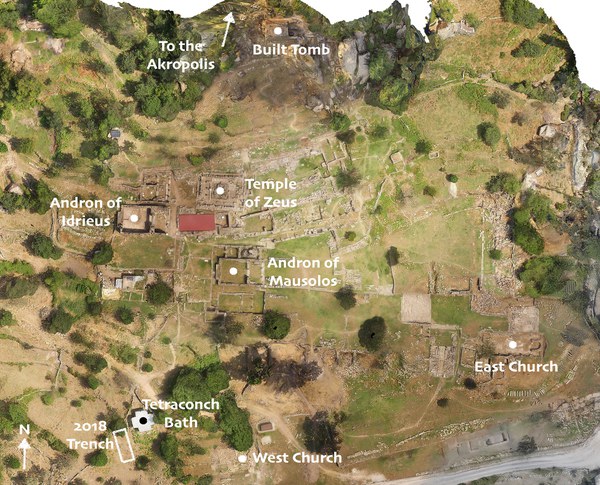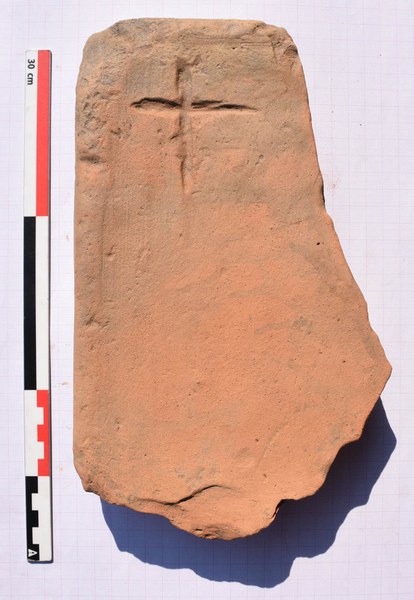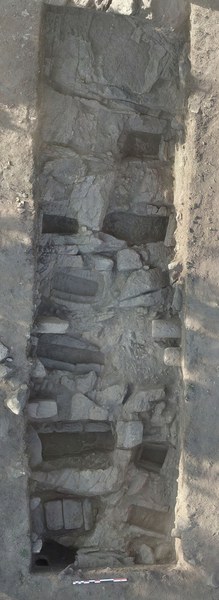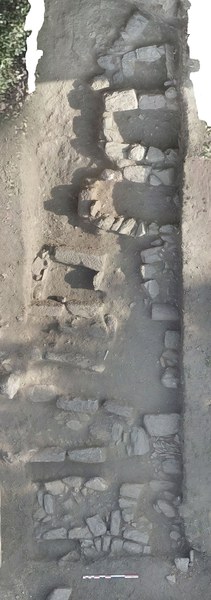In collaboration with a team of students and local workers, my archaeological project at Labraunda, Turkey (director: Olivier Henry) in the summer of 2018 uncovered an early Byzantine cemetery in the southwestern sector of the site. The sanctuary of Zeus at Labraunda functioned from at least the late classical through the Roman period, but the transition to Christianity has heretofore been difficult to chart outside of the two excavated churches.
The humble graves excavated in 2018 therefore offer a rare glimpse of the individuals who lived at the site in approximately the sixth century CE, and the changing usage of the former sanctuary area. These tombs, cut into the bedrock and marked in some cases with crosses etched on bricks, are associated with a nearby church and are only meters away from an earlier private bath attached to a late Roman villa. The density of tombs suggests a sizable agricultural settlement in the area after the villa had fallen out of use. Future analysis of the skeletons found in the tombs will shed more light on the identity and health of the early Byzantine inhabitants of Labraunda. This project adds new data on the Christianization of pagan sanctuary sites, shifting the focus to questions of daily life (and death) rather than religious motivations.
A Dumbarton Oaks project grant allowed me to carry out archaeological fieldwork from July 23 to August 22, 2018, as a part of the Labraunda excavation team in southwestern Turkey (director: Dr. Olivier Henry). My project focused on the early Byzantine period and the transition from paganism to Christianity, as the formerly pagan sanctuary at Labraunda found new uses in the period of Christian dominance.

Labraunda (near modern Milas, Turkey) was situated in the mountainous inland of ancient Caria; a sanctuary at the site was devoted to Zeus Labraundos (with a labrys, a double axe). Labraunda and its sanctuary were monumentalized in the mid-fourth century BCE by members of the Carian Hekatomnid dynasty. Hekatomnos and his sons Mausolos (builder of the famous Mausoleum at nearby Halikarnassos) and Idrieus incorporated elements of Hellenic culture and art in their dynastic presentation, even as they functioned as Persian satraps. Both Mausolos and Idrieus built impressive structures, including the Temple of Zeus and two andrones, spaces for feasting. Labraunda continued to host a sanctuary in the Hellenistic and Roman periods, when new structures, such as baths, were built at the site. The end of pagan worship at Labraunda cannot be pinpointed, but at some point the temple was partially disassembled and an olive press was installed in one of the andrones. A later Byzantine settlement has been found on the fortified acropolis north of the sanctuary.
The aim of my project is to better understand this shift in site usage between the pagan and Christian periods, from a space identified with polytheist ritual to one serving as a settlement dependent on agricultural activities. In 2017, I led a team in excavating two olive presses installed just north of the sanctuary next to the large late-classical built tomb, indicating the encroachment of mundane activity into the sacred and commemorative areas of the site (preliminary report forthcoming in Anatolia Antiqua XXVI, 2018).
Jesper Blid has recently published the architectural remains of early Byzantine Labraunda (Labraunda 4, 2016), including two churches at the fringes of the site (the West Church and the East Church) and a Tetraconch Bath near the West Church, which Blid excavated from 2008 to 2009. Small baths of this architectural type are typically attached to late Roman villas, rather than standing alone or as part of a public bath; it is therefore assumed that the Labraunda Tetraconch was part of an elite domestic structure. Based on the architectural form and a coin, the Tetraconch Bath is dated to ca. 300 CE. The West Church was constructed in the fifth century, and the use of the Tetraconch structure was changed around 500 CE, when the hypocaust heating system was filled up. The new function of the room, and its relation to the nearby church, is unclear.
My initial goal with this season’s fieldwork was to better understand the date and extent of this villa attached to the Tetraconch Bath. A few walls are visible in the area on the surface, and we therefore opened a 12 × 2.80 m test trench to the west of the Tetraconch to seek the continuation of one of these walls. It was my hope that by finding a residential space, the project could shed light on the lived experience of the early Byzantine inhabitants of Labraunda through this architectural proxy. Instead of a domestic structure, however, the excavation uncovered the early Byzantine inhabitants themselves. Twelve graves were found partially or fully within our trench. The graves were cut into the bedrock on an east–west axis.
After the deceased individual was placed in the grave, rough stone slabs were laid over the opening; the whole was then covered over with dirt, and stones were arranged on the surface to create an outline of the grave below.

Pieces of tiles or bricks were placed vertically at the east, and also in some instances at the west, of these stone borders. Three of these bricks had simple crosses etched onto them; an additional two bricks with crosses were placed underneath the slab of one of the graves, confirming the Christian identity of the individuals buried.
It is exceptional at Labraunda to find skeletal remains even in unplundered graves; of the more than one hundred ancient graves identified in the hinterland of the sanctuary, very few contained bones. This is because the chemical qualities of the soil around Labraunda cause skeletons to disintegrate completely. Our early Byzantine graves produced three well-preserved and six partially preserved skeletons. The bodies were laid with the heads at the west; in one instance, the deceased had an arm crossed over the chest (grave C21). At least one of the graves, with a length of one meter, was for a child.
These tombs were humble, lacking elaborate grave goods or decoration beyond the roughly etched crosses on some of the bricks. The only ceramics found in the tombs were small, non-joining fragments in the dirt, rather than vessels intentionally deposited as grave goods. An illegible coin was found in the child’s grave, but it is unclear whether it was an intentional offering or simply an earlier coin within the soil matrix that filled the tomb. Two of the graves contained small pieces of bronze, either jewelry or appliqué pieces. Only one of the graves suggests a richer or more distinguished individual: an exceptional cut rock crystal gem was found in the grave, and the upper stone border was marked with numerous bricks laid vertically between the stones, covering over the entire tomb.
Future analysis of the ceramics and potential C14 dating of the bones will give further precision on the time period of these burials; preliminary examination of the pottery finds by Vasilica Lungu suggests that the latest sherds associated with the burials can be dated to the fifth or sixth century. The burials are only a few meters outside the Tetraconch Bath, which attests to a dramatic shift in usage of the area over the course of a few centuries, from an elite domestic space to cemetery. The short segment of wall visible on the surface, which we had identified at the beginning of the season as belonging to the villa, was completely robbed out before the burials took place. After the construction of the Tetraconch around 300, therefore, the entire area apparently became associated with the West Church in the fifth century or later, when the bath function of the Tetraconch was abandoned in favor of using the room for another, uncertain purpose. It was perhaps around this time that graves began to be dug in the surrounding area.
The discovery of the graves is significant because it gives us our first glimpse of the inhabitants of early Byzantine Labraunda. The method of burial—tombs carved into the bedrock and covered over with slabs—was in use at Labraunda from at least the fifth century BCE; the religion of the inhabitants of the site may have changed, but basic burial habits did not. The cemetery was located outside the sanctuary and inhabited area of the site proper, as were earlier burials. The density of the early Byzantine burials (separated by a meter or less) and the consistency of the tomb construction, with upper stone borders delineating the rock-cut graves below, may indicate that the burials took place over a short time, perhaps suggesting a disease, famine, or other calamitous occurrence.
Further study of all the season’s finds is planned; a collaborator will be sought to study the skeletal remains, along with funds for scientific testing such as C14, DNA extraction, and strontium analysis (which will indicate whether these individuals grew up in the region or immigrated to Labraunda from elsewhere). Next year, I plan to open a new trench closer to the West Church, which should uncover burials immediately outside of the church and the connection between the church and surrounding structures.
I thank Dumbarton Oaks for their generous support of this project, which adds valuable data to our understanding of early Byzantine Labraunda. I also wish to thank the local authorities and my collaborators at the excavation. My project group this year included students at the PhD, MA, and BA levels, and local workers; many other scholars on the Labraunda team offered valuable insight. I wish to thank all these individuals and especially the excavation director, Dr. Olivier Henry. The results of the field season have offered the rare opportunity to study not only the process, but also the people, of the Christianization of Asia Minor.




